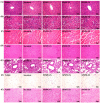Effects of Perch Essence Supplementation on Improving Exercise Performance and Anti-Fatigue in Mice
- PMID: 35162178
- PMCID: PMC8834868
- DOI: 10.3390/ijerph19031155
Effects of Perch Essence Supplementation on Improving Exercise Performance and Anti-Fatigue in Mice
Abstract
Silver perch (Bidyanus bidyanus) has many nutrition and health benefits, being a rich source of macro and micronutrients, phospholipids, polyunsaturated fatty acids, and a variety of essential minerals while having a high protein content. In addition to direct consumption, it is often made into a soup as an important nutritional supplement for strengthening the body and delaying fatigue. By extracting the essence, its quality can be controlled, and it is convenient to supplement. This study aimed to evaluate the effect of supplementation with Santé premium silver perch essence (SPSPE) on improving exercise performance and anti-fatigue. Fifty male institute of cancer research (ICR) mice were divided into five groups (n = 10/group): (1) vehicle (vehicle control or water only), (2) isocaloric (0.93 g casein/kg/mice/day), (3) SPSPE-1X (0.99 g/kg/mice/day), (4) SPSPE-2X (1.98 g/kg/mice/day), and (5) SPSPE-5X (4.95 g/kg/mice/day). A sample or an equal volume of liquid was fed orally for four consecutive weeks. Grip strength and swimming exhaustion tests were used as exercise performance assessments. After 10 and 90 min of unloaded swimming, biochemical parameters of fatigue were evaluated. We found that supplementation with SPSPE for four consecutive weeks could significantly improve mice's grip strength, exercise endurance performance, and glycogen content (p < 0.05), and significantly reduced post-exercise fatigue biochemical parameters, such as lactate, blood ammonia (NH3), blood urea nitrogen (BUN) concentration, and muscle damage index creatine kinase (CK) activity (p < 0.05). In summary, supplementation with SPSPE for 4 weeks could effectively improve exercise performance, reduce sports fatigue, and accelerate fatigue recovery. In addition, it did not cause any physiological or histopathological damage.
Keywords: anti-fatigue; exercise performance; fish soup; perch essence.
Conflict of interest statement
The authors declare no conflict of interest.
Figures





Similar articles
-
Establishment and identification of an animal model of long-term exercise-induced fatigue.Front Endocrinol (Lausanne). 2022 Aug 26;13:915937. doi: 10.3389/fendo.2022.915937. eCollection 2022. Front Endocrinol (Lausanne). 2022. PMID: 36093084 Free PMC article. Review.
-
Anti-fatigue Effects of Santé Premium Silver Perch Essence on Exhaustive Swimming Exercise Performance in Rats.Front Physiol. 2021 Mar 22;12:651972. doi: 10.3389/fphys.2021.651972. eCollection 2021. Front Physiol. 2021. PMID: 33828489 Free PMC article.
-
Capsaicin Supplementation Reduces Physical Fatigue and Improves Exercise Performance in Mice.Nutrients. 2016 Oct 20;8(10):648. doi: 10.3390/nu8100648. Nutrients. 2016. PMID: 27775591 Free PMC article.
-
Kefir Supplementation Modifies Gut Microbiota Composition, Reduces Physical Fatigue, and Improves Exercise Performance in Mice.Nutrients. 2018 Jul 4;10(7):862. doi: 10.3390/nu10070862. Nutrients. 2018. PMID: 29973525 Free PMC article.
-
Ergogenic Effects of Green Tea Combined with Isolated Soy Protein on Increasing Muscle Mass and Exercise Performance in Resistance-Trained Mice.Nutrients. 2021 Dec 18;13(12):4547. doi: 10.3390/nu13124547. Nutrients. 2021. PMID: 34960099 Free PMC article.
Cited by
-
The Protective Effects of Perch Essence Against Muscle Atrophy in Cancer Cachexia and Cisplatin Treatment.Curr Issues Mol Biol. 2025 Feb 26;47(3):152. doi: 10.3390/cimb47030152. Curr Issues Mol Biol. 2025. PMID: 40136406 Free PMC article.
-
Dual-factor model of sleep and diet: a new approach to understanding central fatigue.Front Neurosci. 2024 Sep 17;18:1465568. doi: 10.3389/fnins.2024.1465568. eCollection 2024. Front Neurosci. 2024. PMID: 39355851 Free PMC article.
-
Supplementation with Live and Heat-Treated Lacticaseibacillus paracasei NB23 Enhances Endurance and Attenuates Exercise-Induced Fatigue in Mice.Nutrients. 2025 Aug 7;17(15):2568. doi: 10.3390/nu17152568. Nutrients. 2025. PMID: 40806152 Free PMC article.
-
Probiotic Lactiplantibacillus plantarum Tana Isolated from an International Weightlifter Enhances Exercise Performance and Promotes Antifatigue Effects in Mice.Nutrients. 2022 Aug 12;14(16):3308. doi: 10.3390/nu14163308. Nutrients. 2022. PMID: 36014816 Free PMC article.
-
Establishment and identification of an animal model of long-term exercise-induced fatigue.Front Endocrinol (Lausanne). 2022 Aug 26;13:915937. doi: 10.3389/fendo.2022.915937. eCollection 2022. Front Endocrinol (Lausanne). 2022. PMID: 36093084 Free PMC article. Review.
References
-
- Weichselbaum E., Coe S., Buttriss J., Stanner S. Fish in the diet: A review. Nutr. Bull. 2013;38:128–177. doi: 10.1111/nbu.12021. - DOI
-
- Erkan N., Özden Ö. Gutted and un-gutted sea bass (Dicentrarchus labrax) stored in ice: Influence on fish quality and shelf-life. Int. J. Food Prop. 2006;9:331–345. doi: 10.1080/10942910600596373. - DOI
Publication types
MeSH terms
Substances
LinkOut - more resources
Full Text Sources
Research Materials

